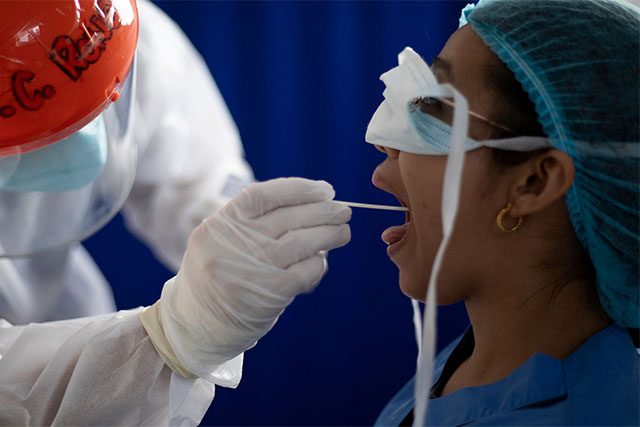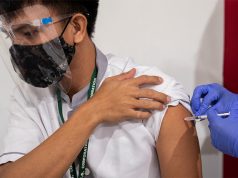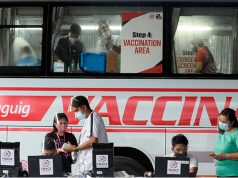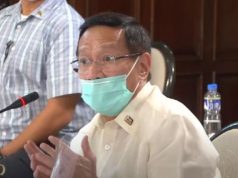
The claim of the national government’s COVID-19 task force that the country is slowly flattening the curve ran counter to the data presented by a number of independent case trackers.
The Inter-Agency Task Force for Emerging Infectious Diseases announced on May 5 that the Philippines sees a slowdown in the rate of COVID-19 infections, therefore showing flattening the curves for new cases and deaths.
To recall, flattening the curve refers to reducing the number of cases of the new pathogen to a manageable size. This has been the goal of health organizations globally since the virus which causes COVID-19 can no longer be stopped.
Last week, John Wong, a doctor member of the IATF, presented graphs to reporters at a virtual press briefing that showed the death rate has been slowing down since last April
“The deaths started very fast. Then we start to see it flattening. Deaths are flattening at a more dramatic rate. Near the 7-day line,” Wong said.
Malacañang similarly claimed that the country is starting to flatten the curve in the past few days and attributed this success to the national government’s quarantine measures.
The national government extended the enhanced community quarantine to areas considered at high risk of COVID-19 infections until May 15. Areas considered at moderate and low risk of transmissions are placed under general community quarantine, which is also scheduled to end on the same date.
Vince Dizon, newly assigned deputy chief implementer of IATF, also said in a virtual press briefing last Tuesday that the government eyes to have a testing capacity of 30,000 per day.
In an interview with ANC last May 8, Dizon said that the country already has a laboratory capacity of conducting around 12,000 tests per day.
Despite this capacity, he said that only around 7,000 tests are being conducted daily.
“But again, that’s just capacity. The other thing that needs to be done is to increase our ability to get the specimen from our kababayans (countrymen) on the ground,” Dizon said.
Aside from being a member of the IATF, Dizon also holds other titles—the president and chief executive officer of the Bases Conversion and Development Authority and the Presidential adviser for Flagship Programs and Projects, which leads the Duterte administration’s Build, Build, Build infrastructure program.
Discrepancies from COVID-19 trackers
Some Filipinos noticed discrepancies in the data the task force is presenting to the public compared with the data from independent case trackers.
PH COVID-19 testing,
aspirations vs reality:
•DOH targeted 8,000 tests/day by Apr 30. Missed target;
•Vince Dizon, May 8, PH capacity now at 12,000 COVID-19 tests daily;
•Vergeire, May 5, Backlog is at 8,000 tests;
•Actual: Average 5,920 tests daily for the past 7 days.— Dan Santos (@DanSantos8) May 8, 2020
COVID-19 tracker website called covid19stats.ph showed that the total test conducted as of May 9 is at 163,177. On the other hand, the average number of tests conducted daily is 5,985 for the past seven days as of the same period.
Meanwhile, the total of individuals who underwent test on the same period is 149,640. The Philippines is testing an average of 5,775 individuals daily for the past seven days.
This website was created by data scientist Mikko Gozalo and two other individuals based on the website’s information.
The data came from the DOH Data Drop, the JHU Coronavirus Resource Center for Global Data and the 2015 census for the population.

Another tracker called endcov.ph, which is handled by the University of the Philippines, also showed different figures. According to the website’s monitoring, as of May 11, the total number of tests is 151,080 and the number of individuals tested is 137,055.
This COVID-19 tracker, however, does not show the average of tests conducted daily.
These figures are the same as the ones shown on DOH’s official tracker.

Over the weekend, an online user who claimed to be a medical frontliner claimed that the Research Institute for Tropical Medicine and the Lung Center of the Philippines are no longer accepting swab samples because of their backlogs.
Hello @PinoyAkoBlog!
Speaking from experience here pero you can check by calling them pero RITM and LCP are no longer accepting swab sample. The sample we sent like 4-5 weeks ago, no results yet. Our patients died na. I'm a frontliner with s/s pero can't send my swas sample.
— JI (@savingjustineph) May 10, 2020
Backlogs are specimens from tested individuals which were not yet processed for results.
In an interview on Monday, Dizon said that there’s a huge backlog.
“Coronavirus testing is a complex process with many moving parts. First you have to get specimens, which requires a huge amount of effort on the LGU level. We’re finding a way to make the process more efficient,” COVID-19 response deputy chief implementor was quoted as saying by CNN Philippines.
“Malaki ang backlog. In the past 2 weeks, our lab capacity was low. It was only when more labs were accredited that our capacity increased,” he added.
Dizon said that the government is trying to get the “the backlog from the initial government labs and bringing them to new labs, mostly from private sector.”
Health Undersecretary Maria Rosario Vergeire previously admitted that some testing facilities have been experiencing a backlog of COVID-19 tests.
She also clarified that flattening the curve also needs to include other factors such as improvement of testing capacity and the rate of determining suspected and positive individuals.
“Pero ngayon nakakapagtest na tayo, medyo lumawak ang capacity natin, nadidilute na symptomatic, mild na talagang hindi nagpopositibo. Nakikita natin na bumababa ang positivity rate natin which is a good indication again for all of us,” Vergeire said.









